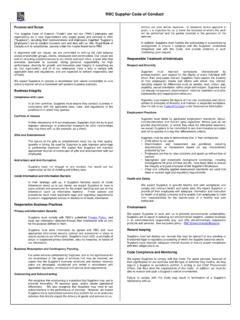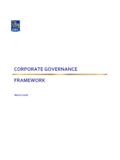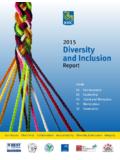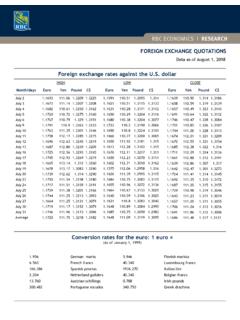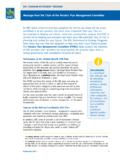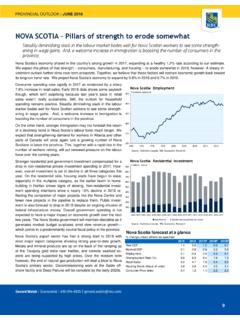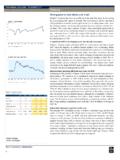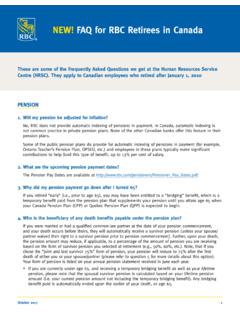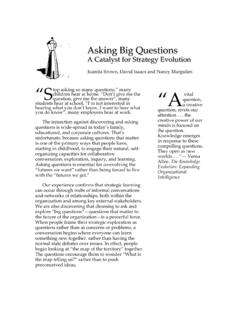Transcription of RBC Environmental Blueprint
1 RBC Environmental Blueprint RBC. Environmental . Blueprint . As one of Canada's largest banks and one of the largest While we are proud of our past and current activities, banks in the world, we recognize the impact we have we don't want to be complacent. This document is in the communities in which we live and work. We are an updated version of the original Blueprint . The new committed to proactive and prudent management of the RBC Environmental Blueprint sets out our corporate Environmental aspects of our business. Since developing Environmental policy, priorities, objectives and includes our first Environmental policy in 1991, we have been numerous ambitious new commitments that will drive focused on Environmental management and continuous our Environmental sustainability programming through improvement.
2 We published our first RBC Environmental to the end of 2018. Blueprint in 2007 to support this commitment, and we are proud of the many accomplishments1 achieved since its launch. April 2014 RBC Environmental Blueprint 1. Contents I. Environmental Policy 3. II. Priority Environmental Issues 3. Climate Change 3. Water 4. Sustainable Communities 4. III. Priority Environmental Objectives 5. Reduce Our Environmental Footprint 5. Manage Environmental and Social Risk 7. Offer Environmental Products, Services and Advice 8. Promote Environmental Sustainability 9. IV. Governance 10. Oversight and Responsibility 10. Measurement and Reporting 10.
3 Endnotes 11. I. Environmental Policy The following elements will guide our Environmental initiatives: E nvironmental Footprint Reduction: RBC will pro-actively apply sound Environmental practices to internal operations and purchasing decisions. We will seek ways to minimize our consumption of resources, including energy, paper and water, and our generation of waste and emissions. We will help create opportunities for our suppliers and employees to do the same. Responsible Business: RBC will develop, maintain, and communicate effective policies, procedures, standards and guidelines for our business activities, to address Environmental issues and risks material to RBC, its clients and its other stakeholders.
4 Products, Services and Business Opportunities: RBC will provide clients with innovative, practical and cost- effective financial products and services to promote environmentally sustainable choices. We will seek out business opportunities that promote Environmental sustainability and provide business benefit. Employee Involvement: RBC will offer Environmental education and tools to our employees worldwide to enable them to act in an environmentally responsible manner, and support our company's objectives. We will also provide our employees opportunities to become personally engaged in Environmental sustainability initiatives that are important to our business.
5 Compliance: RBC will responsibly manage all aspects of our business to ensure Environmental laws and recognized standards are met. We will monitor compliance with our own policies, procedures, and standards. Reporting and Transparency: RBC will report regularly on our key Environmental performance indicators. We will continue to improve our system for monitoring, measuring and transparent reporting of our performance relative to our targets, priorities and objectives. Promote Sustainability: RBC will establish and maintain productive partnerships with experts and stakeholders to ensure that we remain informed about relevant concerns and issues and are well-positioned to manage Environmental risks and opportunities.
6 We will provide support for selected non-profit groups working to address Environmental issues of importance to RBC and our stakeholders. II. Priority Environmental Issues The Environmental issues facing our planet are complex and growing in number and importance. We will continue to manage the many Environmental issues that can give rise to risks or opportunities, and will focus our Environmental efforts on the following three key issues: Climate Change Climate change presents Environmental , social and financial challenges to the global economy, human health and our own business and operations. Climate change is caused by both natural variations and human activity, most notably greenhouse gas (GHG) emissions from the combustion of fossil fuels and the large-scale removal of vegetation.
7 Strategies to address climate change may focus on mitigation efforts to curtail GHG emissions and adaptation to ensure communities can survive the physical effects of a changed climate. Around 80% of the world's anthropogenic GHG emissions are the result of energy production and consumption. Strategies to reduce GHG emissions and mitigate the impacts of climate change commonly include policies to encourage clean technology, energy efficiency and renewable energy development. These can stimulate new economic opportunities for businesses and innovation in certain sectors. April 2014 RBC Environmental Blueprint 3. A changing climate means more than just a rise in average temperature.
8 It also means an increase in extreme and unpredictable weather events, changes in water quality and availability in different regions, ecosystem impacts, and effects on human health. Communities and businesses must adapt to the changing climate and ensure that their populations, economic activities and infrastructure can withstand extreme weather and climate impacts. We must continue to understand the evolving scope of risks and opportunities associated with mitigating and adapting to climate change. This enables us to continue to respond to the needs of our clients, shareholders, employees and other stakeholders when providing financial services, operating our facilities and supporting our communities.
9 Water Water shortages and lack of access to clean, fresh water are considered to be two of the largest threats to human health and economic development around the world. A number of factors are exacerbating water quality and availability issues. Climate change is causing new and unpredictable changes in water availability, with some regions having too much, and others having too little to meet their needs. Growing populations drive competing demands for clean water, which means that policies need to consider how to allocate it fairly among users, without negatively affecting the natural environment. Many communities are dependent on the preservation and management of the marine and freshwater environment, as their economies require clean water for their tourism, fisheries and other industries.
10 Without clean water, the ability of communities and industries to endure and prosper is limited. In many jurisdictions, industry sectors that depend on water for their operations anticipate tighter regulation, supply restrictions and higher costs. Cities are grappling with the best way to manage water infrastructure in urban settings, with growing populations and unpredictable storm-water flows stressing existing systems. Water quality and quantity issues will present risks and opportunities for businesses across many sectors. We will continue to work to understand the water-related risks and opportunities facing the sectors that we finance and the communities in which we live and work.

